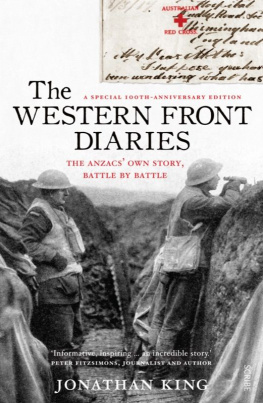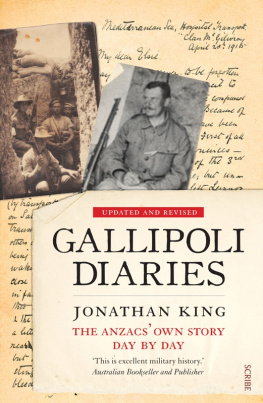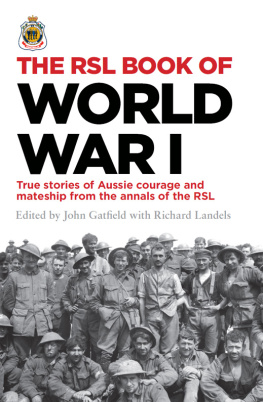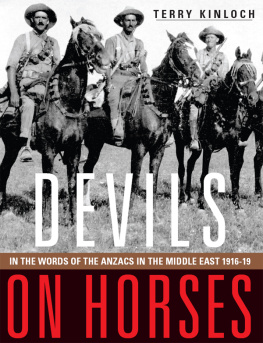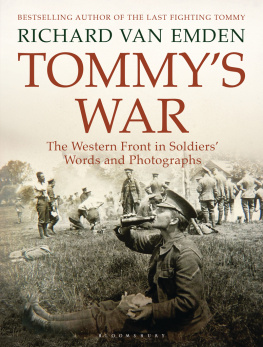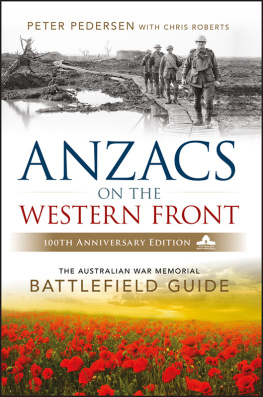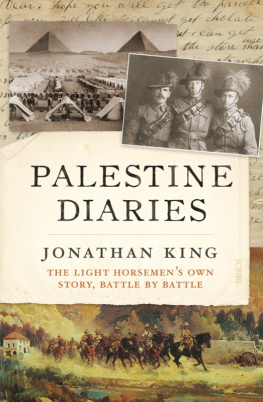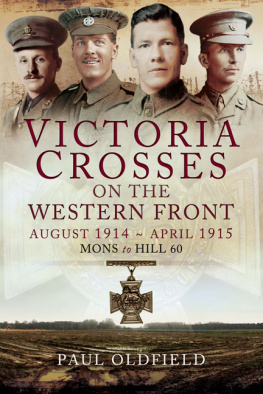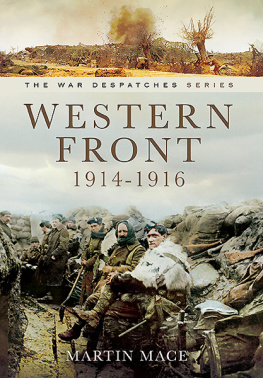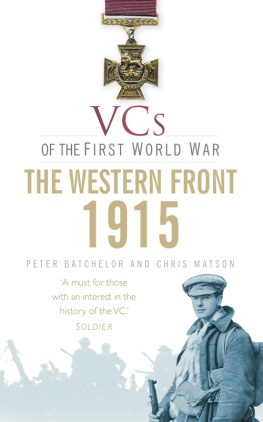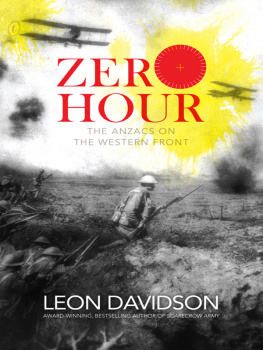THE WESTERN FRONT DIARIES
Award-winning historian Dr Jonathan King is the author of Gallipoli Diaries: the Anzacs own story, day by day (Scribe, 2014), and has been producing books and films about World War I since 1994. He leads battlefield tours to Gallipoli and the Western Front, and is a regular television and radio commentator, as well as a writer for newspapers. After lecturing at the University of Melbourne for many years, he has written more than 30 books and produced 20 documentaries. He is based in Sydney with his fellow adventurer and wife, Jane. They have four daughters and seven grandchildren.
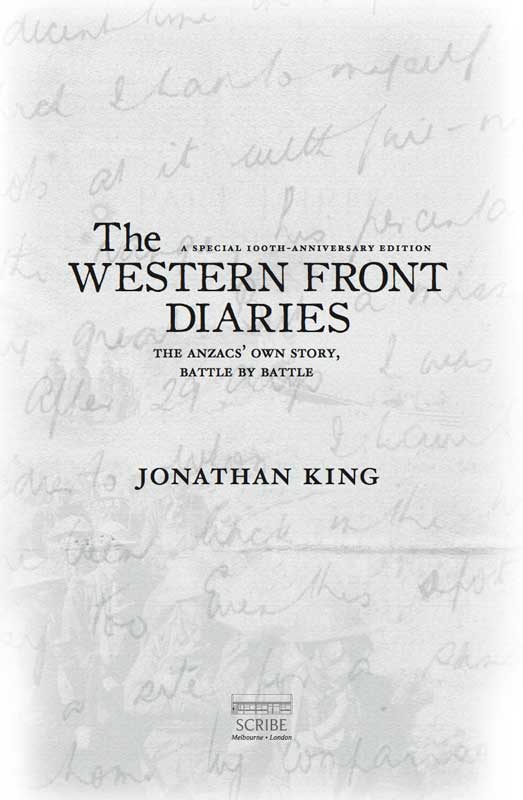
Scribe Publications
1820 Edward St, Brunswick, Victoria 3056, Australia
2 John St, Clerkenwell, London, WC1N 2ES, United Kingdom
First published by Simon & Schuster (Australia), 2008
This revised edition published by Scribe 2015
Copyright Jonathan King 2008, 2010, 2014
All rights reserved. Without limiting the rights under copyright reserved above, no part of this publication may be reproduced, stored in or introduced into a retrieval system, or transmitted, in any form or by any means (electronic, mechanical, photocopying, recording or otherwise) without the prior written permission of the publishers of this book.
National Library of Australia Cataloguing-in-Publication data
King, Jonathan, 1942- author.
The Western Front Diaries: the Anzacs own story, battle by battle / Jonathan King.
Revised edition.
9781925106695 (paperback)
9781925307061 (e-book)
1. Australia. Army. Australian and New Zealand Army CorpsHistory. 2. SoldiersAustraliaDiaries. 3. SoldiersAustraliaCorrespondence. 4. World War, 1914-1918CampaignsWestern FrontPersonal narratives, Australian. 5. World War, 1914-1918BattlefieldsEurope, Western.
940.4144
scribepublications.com.au
scribepublications.co.uk
To the many who gave their lives not only Australians but those from all sides.
CONTENTS
by Dr Brendan Nelson
Five Times Greater Than Gallipoli
All Too Quiet on the Western Front
PART ONE:
A Seemingly Inexorable Build-up
1914: the first year of war
1915: the second year of war
PART TWO:
Battle for Verdun
The First Anzacs Start Leaving Egypt
First Front-line Experience
First Australian Raid
The Battle of the Somme: historys worst battlefield toll
Fromelles: the worst one-day death toll
Pozires: the worst killing field of all
Pozires: Percy Smythes account
Mouquet Farm: dying in the mud
PART THREE:
January 1917: winter report
Germanys Strategic Retreat
Battle for Lagnicourt
Battle of Arras
America Joins the Fray
Battle of Vimy Ridge
: Bullecourt ( I ) & ( II )
Bullecourt ( I ): abandoned by tanks in No-Mans-Land
Lagnicourt: losing and regaining a village on the same day
Bullecourt ( II ): no thanks to the tanks
: Ypres in Flanders
Messines
( I ) Menin Road
( II ) Polygon Wood
( III ) Broodseinde
( IV ) Poelcapelle
( V ) Passchendaele
Battle of Cambrai
PART FOUR:
The German Spring Offensive
: battles that halted the German offensive
Halting Battle ( I ): Hbuterne village
Halting Battle ( II ): first Dernancourt
Halting Battle ( III ): first battle for Morlancourt
Halting Battle ( IV ): first Villers-Bretonneux
Halting Battle ( V ): second Dernancourt
Halting Battle ( VI ): Hangard Wood
Halting Battle ( VII ): Hazebrouck (aka Battle of the Lys)
Battle of Zeebrugge
: Villers-Bretonneux and beyond the Somme
Turning-point Battle ( I ): second Villers-Bretonneux
Turning-point Battle ( II ): second Morlancourt
Turning-point Battle ( III ): Ville-sur-Ancre
Battle of the Aisne
Battle of Cantigny
Battle of Belleau Wood
Battle of Noyon-Montdidier
Turning-point Battle ( IV ): third Morlancourt
: the long-awaited breakthrough
Hamel
: Amiens, Germanys black day
: post-Amiens mop-ups
Mop-up Battle ( I ): Lihons
Mop-up Battle ( II ): Etinehem
Mop-up Battle ( III ): Proyart
Mop-up Battle ( IV ): Transloy-Loupert system
Mop-up Battle (v): Chuignes
: final victory roll
Victory Roll ( I ) & ( II ): Mont St Quentin and Pronne
Victory Roll ( III ): Hindenburg outpost line (aka Hargicourt)
Battle of Argonne Forest (Meuse River)
Victory Roll ( IV ): St Quentin Canal
Victory Roll ( V ): Montbrehain, the Australians last battle
PART FIVE:
Combatants Killed
Total Wounded
Civilian Deaths
Aprs la Guerre
Farewell to Old France Forever
Returning to Australia
Tragedy and Triumph
Success Stories
APPENDIX
FOREWORD
Charles Bean was Australias official World War I historian. Having landed with the Australian troops at Gallipoli, he stayed with them at the Front through the entire war. It was said of Bean that no one had risked death more often than him. Wounded at the Gallipoli August offensive, he refused evacuation such was his commitment to his role and to the men and nurses whose lives, courage, and sacrifice he so painstakingly documented. At Pozires, France, in 1916, Australia suffered 23,000 casualties in just six weeks. In late July, he recorded this in his diary:
Many a man lying out there at Pozires or in the low scrub at Gallipoli, with his poor, tired senses barely working through the fever of his brain, has thought in his last moments: well well its over; but in Australia they will be proud of this.
We are. We are very proud.
At the very end of the official history, which would take almost a quarter of a century to write and edit, when Bean then sought to summarise it all and what it meant, he wrote:
What these men did, nothing can alter now. The good and the bad, the greatness and the smallness of their story will stand It rises as it will always rise, above the mists of ages, a monument to great-hearted men; and, for their nation, a possession forever.
But it was not only what they did, it is also what they wrote. For the first time, on a scale not since seen, these men and women nurses recorded their observations, described the horror, humour, and heroism around them, and expressed their love for family and friends so far away.
The power is in their story and how they told it, especially from France and Belgium from which 46,000 would not ever return, remaining as silent witnesses to the future they have given us.
Among those, author Dr Jonathan King introduces us to Stan Hastings Marchment of the 5th Divisions 14th Machine Gun Company. He was one of the 5,770 Australian casualties on the Menin Road, Belgium in 1917. His brother, Robert, broke the news of Stans death in a letter home:
No doubt youve heard the sad news Before we went out on the night of the 25th Stan had an idea that something was going to happen to him, and he gave a letter to one of our boys to be posted for him in England I think it was to a girl in Wauchope He did not want it censored He went out cheerful as a man ever could, especially when he had an idea he was going to his doom [After he went over the top], he and three other boys were with their Gun digging a position when suddenly the Germans sent a barrage of fire from their heavy batteries into Glencorse Wood where Stan and his mates were, and got all four of them [Stan] suffered no pain as it was an instantaneous death with him Glencorse Wood turned out a veritable hell for our boys and many other good Australian Fathers, Mothers, Sisters, Sweethearts and Brothers
Next page
